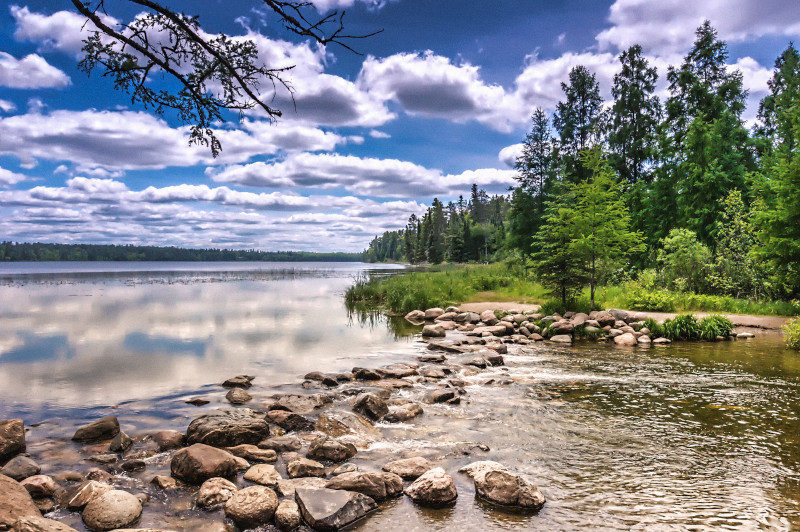
Lake Itasca Facts
- The deceptively simple term of Lake Itasca serves as the most frequently used common name for this lesser-known marvel of Nature. That’s the english language appellation for the lake, though. The ancient Indigenous Peoples of the region had several other names for it.
- The local Ojibwe People, along with other native groups, long knew of the existenceof this marvel og geology, of course. The name they applied to the remarkably beautiful lake was Omashkoozo-zaaga’igan. Loosely translated into english the lengthy moniker meant Elk Lake.
- Among non-native individuals, historians aren’t completely certain who spotted the stunning lake first. Though opinions vary widely, the majority of experts believe that fur trader William Morrison holds that distinction. He sighted it sometime between the years 1803 and 1804.
- No matter who saw it first, or when that sighting occurred, the formation holds a surprising importance in the region in which it lies. That’s because, despite its unassuming appearance, it technically qualifies as the source of the headwaters of the mighty Mississippi River itself!
- Its beauty and importance justifiably earns the stunning Lake Itasca its own appreciation. It now serves as the central feature of the aptly-named Itasca State Park. This fortunately provides the formation with a certain amount of protection from the depredations of man.
Related Articles
Lake Itasca Physical Description
The great natural beauty of Lake Itasca quickly captivates those individuals fortunate enough to visit the amazing site. Yet, unlike some similar features around the world, it does not do so due to its dimensions. That’s due to the surprising fact that, regardless of its importance, it’s relatively small.
It also stands out from most such bodies of water in regards to its general shape, as well. The same geological forces that created this wonder also gave it something of a unique T-shape structure. That section that constitutes the cap of the letter-shape quite distinctively tilts slightly to the left.
Its total surface area only measures a mere 1.8 sq mi (4.7 sq km). Despite the tiny volume of that aspect of the lake, its extraordinarily irregular outline still provides it with at least one respectable dimension. Impressively, this marvel still manages to boast a total shoreline of 14.3 mi (23 km).
Regardless of any other factors, the gorgeous Lake Itasca nevertheless manages to amaze many people due to another characteristic. That factor pertains to its depth. The beautiful tan remains quite shallow in its nature. Its depth also varies greatly because of changes in its own source.
As a general principle, though, that particular aspect only averages measuring between a mere 20 – 35 ft (6.1 – 10.7 m). Yet even at its deepest recorded section, however, its maximum depth has never exceeded 40 ft (12.2 m). Nature, though, has never associated size with impressiveness.
Lake Itasca Location, Formation, and Geography
The magnificent Lake Itasca formed in a region of the globe already renowned for its incredible abundance of widely varied geological wonders. That precise region won’t surprise the people who know of the Mississippi River, though. The site lies within the confines of the United States.
Therefore situated on the continent of North America, the captivating lake resides in the state of Minnesota. That itself sits in what’s considered the Upper Midwest section of the country. Its exact geographical location additionally places it in the general northwestern part of the state.
This small but disproportionately vital body of water itself owes its own formation to a very special set of circumstances. The nature of those factors also explain why the lake’s depth varies so significantly, as mentioned above. That’s because this marvel forms what’s known as a glacial lake.
During the last ice age, retreating glaciers slowly but irresistably carved out the basin where it sits. Following that, numerous naturally occuring springs provided roughly half the water to fill it. The remainder comes from rainfall. Since this varies, it accounts for the widely differing depths.
Even though the amazing Lake Itasca is small, it plays yet another important role. Its exact location coincidentally places it at the convergence of an astounding three distinct ecosystems. These consist of lovely regions of eastern deciduous forest, tall grass prairie, and coniferous forest.
Both flora and fauna common to all three types of region appear in abundance at and around the site. Along with the many grasses and trees, some of the plants present even include wild rice! Animals found here include deer, beaver, porcupines, black bears, wolves, and countless birds.
Features Sharing Its Region
Check out our other articles on 4 Supremely Stunning Squirrels, Eastern Gray Squirrel, Sacred Valley, Desert Willow, Snowflake Moray, Eastern Cicada Killer, Little Auk, Black Mamba
